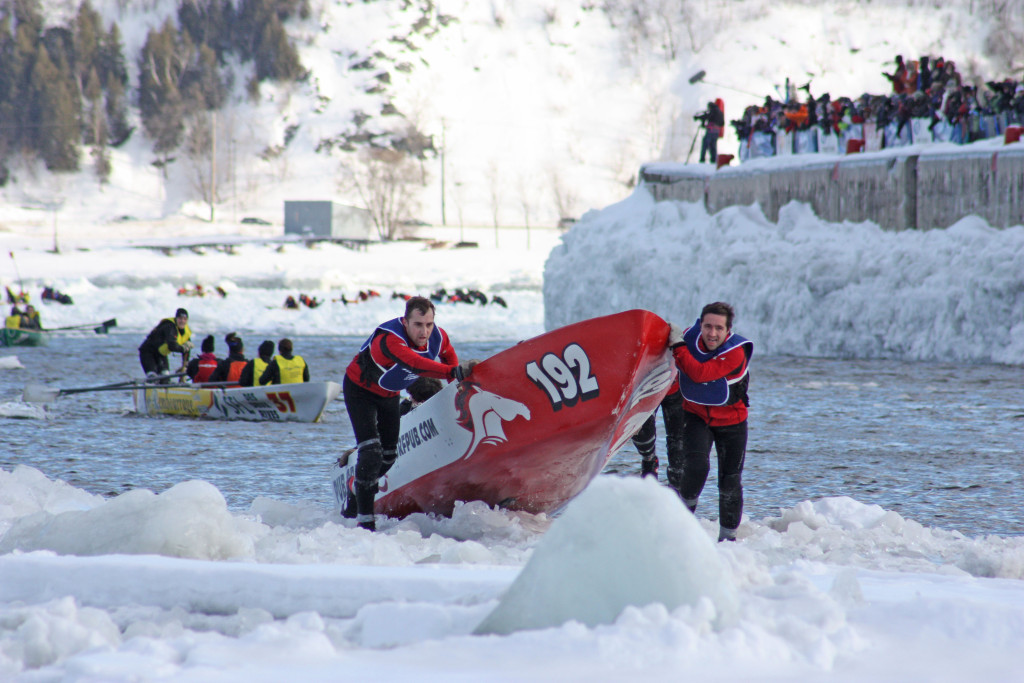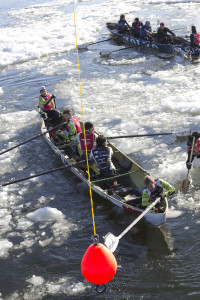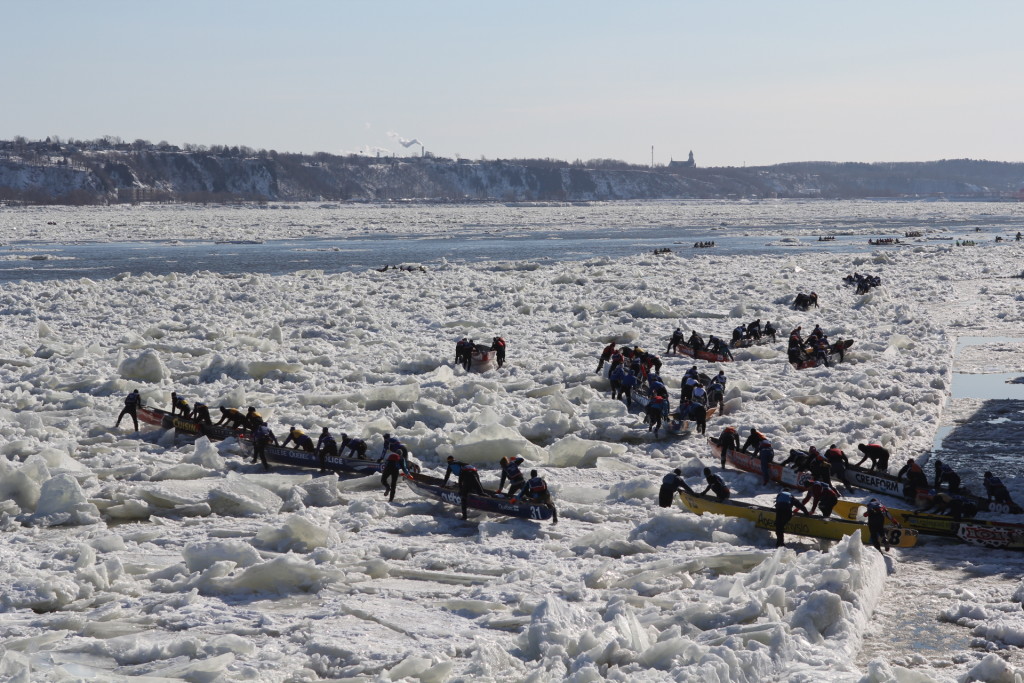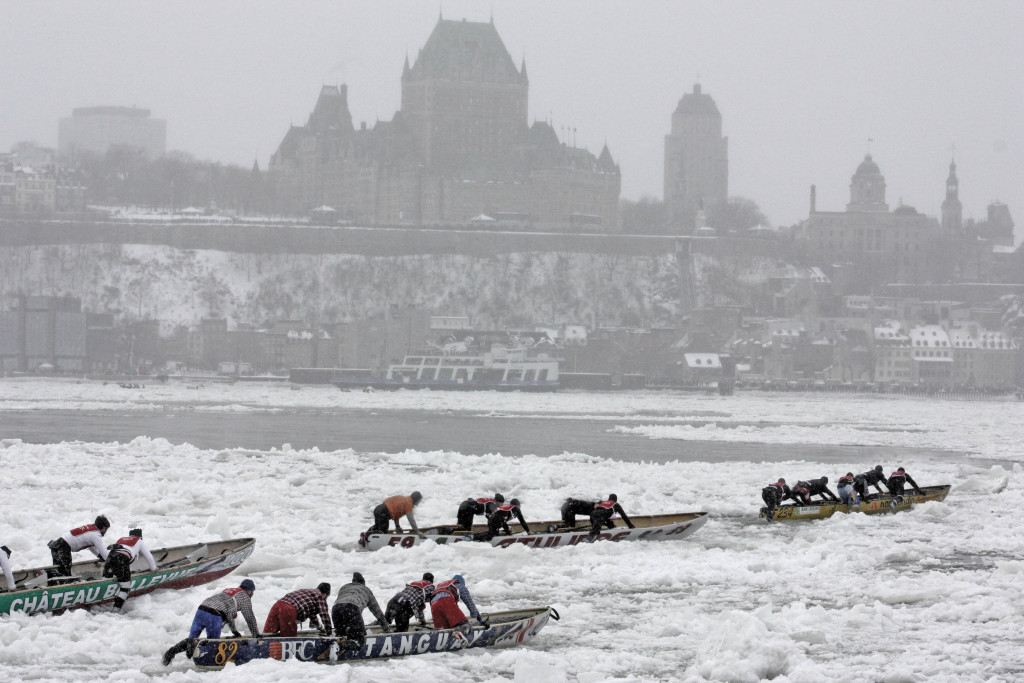For most river sports enthusiasts, the arrival of ice on the river marks the end of the paddling season. However, in Quebec City, the fun is just beginning. Accompanied by hundreds of other spectators, I watched an ice canoeing event for the first time. The practice originally started as a means of moving people and goods across the river and has evolved into an extreme sport.
The Race Is On!
The first sign of the canoe racers’ approach was a loud grinding sound that nearly drowned out the crowd that was gathered along a bank of the St. Lawrence River. Tourists and locals stood in the 5° F weather to watch the yearly spectacle. The announcer reminded the crowd over the speaker system that ice canoeing has been a part of Quebec’s Winter Carnival since its conception. The grinding grew louder as the racers passed in front of me. Initially, I had thought that the sound of the approaching boats was made by paddles hitting blocks of ice. However, once the racers came into view, I realized that their paddles were still stowed in the boats and that the boats themselves were grinding against the ice. The racers were pushing their boats along the top of an ice shelf with their feet, crampons digging into the ice. Typically, the racers would keep one leg in the boat, with their outside leg providing propulsion, timed so that each kick coincided with that of their team mates. The long canoes lurched over chunks of ice. Sometimes, the bow of the boat would rise into the air as the team scaled the ice blocks and the racers in the front of the boat would have to jump in until the bow reached the ice again.
Pushing the boat across the ice was only one part of the challenge. Soon, the first team reached the section where it would have to start across the river, ferrying the current and avoiding the chunks of ice that were carried by the rapidly moving water. The paddles in ice canoeing are long, appearing more like oars than standard canoe paddles. The canoers rowed together across the river, occasionally pulling the boat up onto the ice sheets as they collided, kicking across, and then splashing back into the water. They became silhouettes as their distance from the spectators increased. Shortly, some teams appeared as only a few black dots, barely visible behind chunks of ice along the far shore.
The elite women’s race started as the men crossed the river. Again, there were the loud sounds of the boats racing across the ice. The crowd had thinned, the cold temperature and bitter wind driving many spectators to shelter indoors. Even so, the river bank was still lined with on-lookers bundled in jackets, snow pants, scarves and hats.
The first group of racers sped back across the river, making good time as they travelled with the wind and the current. Most managed to find channels of water between the ice shelves, passing by three tug boats that had positioned themselves in the river for the race. The final set of racers in the sport group left the starting point before the first group of elite men returned the starting area. The men still had another circuit to left in the race and by the time they passed by spectators again, the course seemed truly chaotic. In total, there were 52 boats in the water. Some racers arrived at the finish with others just leaving and the three groups became difficult to differentiate. Canoes seemed to be stuck on the ice left and right, while others tried to paddle their boats around in a narrow channel of water. One racer slipped and fell on the ice. On another portion of the river, canoers tried to position themselves for the best routes with boats side by side.
As they began to cross the river, some for the second time, the crowd grew sparser. A friend and I ducked inside a nearby café to take shelter from the cold and to watch the rest of the event from behind plate glass windows. An hour and a half after the elite men started there were still several boats in the water, the racers obviously tired and moving slowly, worn down by the water, ice, and wind. The banks of the river were empty except for a few children playing as their parents walked along the side. I felt exhausted just from watching the racers. While indoors, I still felt cold and could only imagine the endurance of the athletes who had braved chunks of ice, the swift current, unforgiving weather, and cold water to compete. I was left with a sense of awe.
If the intensity of ice canoeing sounds like a good challenge, you can give it a try. Quebec Ice Canoeing gives participants an introduction to the sport and takes them on a 1 hour excursion. For anyone who is content to just watch the spectacle, the ice canoeing competition is held annually at Quebec City’s Winter Carnival and is free and open to the public. For 2020, the competition will be held on Sunday, Feb 9th.
The featured image for this post was courtesy of the Quebec Winter Carnival.






Awesome article Chrissy, we’ve never heard of crampons being used that way. Ice canoeing is quite intense. We carry Black Diamond crampons now and I guess we should be prepared for any questions regarding ice canoeing. Thanks again!